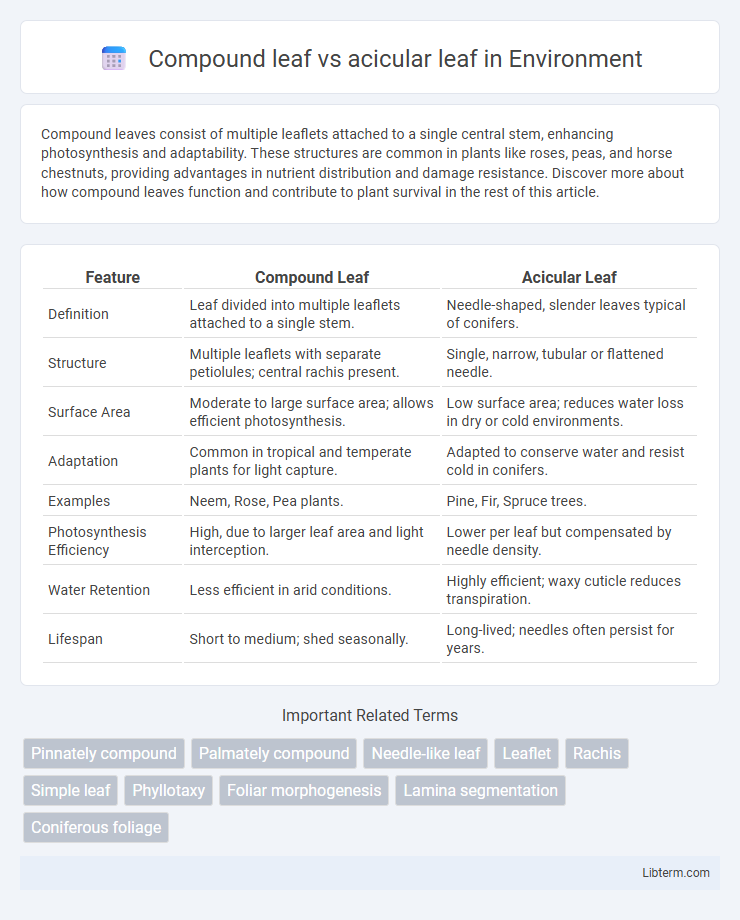Compound leaves consist of multiple leaflets attached to a single central stem, enhancing photosynthesis and adaptability. These structures are common in plants like roses, peas, and horse chestnuts, providing advantages in nutrient distribution and damage resistance. Discover more about how compound leaves function and contribute to plant survival in the rest of this article.
Table of Comparison
| Feature | Compound Leaf | Acicular Leaf |
|---|---|---|
| Definition | Leaf divided into multiple leaflets attached to a single stem. | Needle-shaped, slender leaves typical of conifers. |
| Structure | Multiple leaflets with separate petiolules; central rachis present. | Single, narrow, tubular or flattened needle. |
| Surface Area | Moderate to large surface area; allows efficient photosynthesis. | Low surface area; reduces water loss in dry or cold environments. |
| Adaptation | Common in tropical and temperate plants for light capture. | Adapted to conserve water and resist cold in conifers. |
| Examples | Neem, Rose, Pea plants. | Pine, Fir, Spruce trees. |
| Photosynthesis Efficiency | High, due to larger leaf area and light interception. | Lower per leaf but compensated by needle density. |
| Water Retention | Less efficient in arid conditions. | Highly efficient; waxy cuticle reduces transpiration. |
| Lifespan | Short to medium; shed seasonally. | Long-lived; needles often persist for years. |
Introduction to Leaf Morphology
Compound leaves consist of multiple leaflets attached to a single petiole, enhancing surface area for photosynthesis and providing flexibility against wind damage. Acicular leaves, typical of conifers like pines, are needle-shaped, with a thick cuticle and sunken stomata to minimize water loss in dry or cold environments. Understanding these leaf morphologies is crucial for identifying plant species and studying their adaptations to various ecological niches.
Defining Compound Leaves
Compound leaves consist of multiple leaflets attached to a single central petiole, allowing for increased surface area and flexibility, while acicular leaves are needle-like and typically found in coniferous plants, adapted to reduce water loss. Each leaflet in a compound leaf functions independently but collectively contributes to photosynthesis, contrasting with the singular, slender structure of acicular leaves. The arrangement and morphology of compound leaves enhance light capture and air circulation, distinguishing them from the simple, tough texture of acicular foliage.
Characteristics of Acicular Leaves
Acicular leaves are narrow, needle-like structures typically found in coniferous trees such as pines and firs, designed to minimize water loss and withstand harsh environmental conditions. These leaves have a tough, waxy cuticle and sunken stomata that reduce transpiration, enabling them to thrive in dry or cold climates. Unlike compound leaves, which consist of multiple leaflets, acicular leaves maintain a singular, slender form, enhancing their durability and efficiency in photosynthesis.
Structural Differences: Compound vs Acicular
Compound leaves consist of multiple leaflets attached to a single petiole, allowing greater flexibility and surface area for photosynthesis, whereas acicular leaves are needle-shaped, slender, and typically found in conifers, providing reduced water loss and resistance to harsh climates. Structurally, compound leaves have a complex arrangement with distinct leaflets exhibiting clear venation, while acicular leaves have a simple structure with limited surface area and a thick cuticle. The presence of multiple leaflets in compound leaves contrasts sharply with the singular, narrow form of acicular leaves, highlighting adaptations to different environmental conditions.
Ecological Roles and Adaptations
Compound leaves increase surface area for photosynthesis without increasing wind resistance, aiding plants in diverse environments by optimizing light capture and reducing water loss. Acicular leaves, typical of conifers, have a reduced surface area with thick cuticles and sunken stomata, minimizing water loss in cold or dry habitats. These adaptations allow conifers to thrive in nutrient-poor soils and withstand harsh climatic conditions such as frost and drought.
Photosynthetic Efficiency Comparison
Compound leaves, characterized by multiple leaflets per petiole, generally exhibit greater photosynthetic efficiency than acicular leaves due to increased surface area and light interception capabilities. Acicular leaves, typical of conifers, have reduced surface area and thicker cuticles, minimizing water loss but limiting light absorption compared to compound leaves. The broader, divided surfaces in compound leaves enhance CO2 diffusion and chlorophyll content, optimizing photosynthesis under diverse environmental conditions.
Representative Plant Species
Compound leaves, characterized by multiple leaflets attached to a single petiole, are commonly found in plants such as the neem tree (Azadirachta indica) and the rose family (Rosaceae), including species like the rose (Rosa spp.). Acicular leaves, which are needle-like and slender, are a defining feature of conifers such as pine trees (Pinus spp.) and spruce (Picea spp.), adapted to reduce water loss in cold or dry environments. These representative species illustrate the adaptation of leaf morphology to specific ecological niches and functional requirements.
Evolutionary Significance
Compound leaves and acicular leaves represent distinct evolutionary adaptations to environmental pressures. Compound leaves, characterized by multiple leaflets, enhance light capture and reduce wind resistance, beneficial for plants in diverse habitats. Acicular leaves, typical of conifers, minimize water loss and withstand cold or dry conditions, reflecting adaptation to harsh climates over millions of years.
Advantages and Disadvantages
Compound leaves offer increased surface area for photosynthesis and better wind resistance, reducing damage during storms, but their complex structure can require more energy for maintenance and repair. Acicular leaves, typical of conifers, minimize water loss due to their small, needle-like shape and thick cuticle, making them advantageous in dry or cold environments, though their limited surface area reduces overall photosynthetic capacity. The trade-off between these leaf types reflects adaptations to environmental stress and resource availability, influencing plant survival and growth strategies.
Conclusion and Summary
Compound leaves consist of multiple leaflets attached to a single petiole, allowing for increased surface area and flexibility, while acicular leaves are needle-like, typically rigid, and adapted for water conservation in coniferous plants. The structural differences reflect their ecological adaptations, with compound leaves favoring broadleaf tree environments and acicular leaves thriving in harsh, dry, or cold climates. Understanding these distinctions facilitates better identification and study of plant species based on leaf morphology and environmental adaptation.
Compound leaf Infographic

 libterm.com
libterm.com